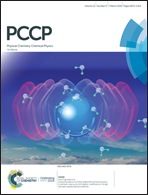First-principles study of intrinsic point defects in MgSiAs2
Abstract
MgSiAs2 is a potential infrared-nonlinear optical (IR-NLO) material, due to its fine second harmonic generation (SHG) performance and high laser damage threshold (LDT). In this study we systematically investigate its native point defects including vacancies, interstitials, and antisites using first-principles calculations with the Heyd–Scuseria–Ernzerhof hybrid functional. The defect formation energies and transition levels at the dilute limit are evaluated. Of the thirteen different point defects studied, nine kinds of defects show deep transition levels, which might contribute to the limiting of the transparency spectrum of MgSiAs2 compounds. The defects with the highest concentration at equilibrium are found to be cation antisites, MgSi and SiMg, serving as acceptors and donors respectively. Because of their significantly low formation energies, they lead to Fermi level pinning in the band gap and constrain the carrier concentration doping. Our calculations show that a change in growth conditions affects modestly the formation energy of defects or the concentration of charge carriers.



 Please wait while we load your content...
Please wait while we load your content...